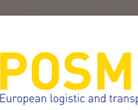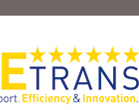1.) INNOSUTRA - Innovation Processes in Surface Transport
The main idea behind INNOSUTRA is to advance innovation integration in transport and logistics chains by focusing on improved market understanding, knowledge management and network organisation. To this end, the project aims at:
· Identifying the key players for innovation ("pioneer investors").
· Assessing how innovation gets adopted and spreads in the market.
· Determining how innovation could be stimulated, among others through policy, in networks.
· Viewing key determinants of successful innovative concepts
· Formulating clear policy conclusions on how governments can and should best impact on the above issues.
2.)
APROSYS - Integrated Project on Advanced PROtection SYStems
World-wide, vehicle safety experts agree that significant further reductions in fatalities and injury numbers could be achieved by deploying appropriate passive (or crash) safety strategies. The FP6 APROSYS Integrated Project (IP) answers to this call by development and introduction of critical technologies that improve passive safety for all European road users for priority accident types and levels of crash severity.
The field of passive safety concerns in particular human injury biomechanics, vehicle crashworthiness and protection systems. APROSYS is mobilizing and integrating the European scientific & technological expertise for the development of new technologies for the protection of road users in all relevant accident conditions. Furthermore, this IP aims to increase the level of competitiveness of the European industry by developing new safety technologies.
3.)
HUMANIST - Human centred design for Information Society Technologies
This Network of Excellence aims to create an European Virtual Centre which will allow the:
· strengthening the R&D of European industries with potential inputs
· harmonisation of the road safety and ITS approaches to the societal benefits assessment among the Member States
· quick reaction to any new technological development
In the coming years, the development of new technologies of information and communication will deeply transform transport uses and practices. If the driving task has evolved little since the creation of the motor vehicle, now is the time for rapid change due to the combined effect of widespread of in-vehicle driver information and communication systems and the emergence of advanced driver assistance systems.This Network of Excellence aims to create an European Virtual Centre which will allow the:
4.)
SEVECOM - Secure Vehicle Communication
Sevecom focuses on communications specific to road traffic. This includes messages related to traffic information, anonymous safety-related messages, and liability-related messages. The following research and innovation work is foreseen:
Identification of the variety of threats: attacker's model and potential vulnerabilities; in particular, study of attacks against the radio channel and transferred data, but also against the vehicle itself through internal attacks, e.g., against TCU (Telematics Control Unit), ECU (Electronic Control Unit) and the internal control bus.
Specification of an architecture and of security mechanisms which provide the right level of protection. It will address issues such as the apparent contradiction between liability and privacy, or the extent to which a vehicle can check the consistency of claims made by other vehicles. The following topics will be fully addressed : Key and identity management, Secure communication protocols (including secure routing), Tamper proof device and decision on crypto-system, Privacy. The following topics will be investigated in preparation of further work: Intrusion Detection, Data consistency, Secure positioning, Secure user interface.
The definition of cryptographic primitives which take into account the specific operational environment. The challenge is to address (1) the variety of threats, (2) the sporadic connectivity created by moving vehicles and the resulting real-time constraints, (3) the low-cost requirements of embedded systems in vehicles. These primitives will be adaptations of existing cryptosystems to the VC environment.
5.)
AIDE - Adaptive Integrated Driver–vehicle Interface
The objectives of AIDE are:
· to maximise the efficiency, and hence the safety benefits, of advanced driver assistance systems,
· to minimise the level of workload and distraction imposed by in-vehicle information systems and nomad devices and
· to enable the potential benefits of new in-vehicle technologies and nomad devices in terms of mobility and comfort.
6.) EURAMP – EUropean RAmp Metering Project
The major objective of the EURAMP project is to advance, promote and harmonise ramp metering control measures in European motorways in the aim of improving safety and increasing efficiency of traffic flow. This major objective is pursued within EURAMP via a number of multifaceted actions and sub-objectives:
Advancement of methodological issues, with particular focus on traffic flow safety, to secure a European technological leadership in the area.
Consolidation, harmonisation and advancement of ramp metering practice in Europe.
Demonstration of new developments in European sites and paving the way for a new generation of extended (network-wide) ramp metering installations.
Co-operation of ramp metering with signal control and further heterogeneous control measures for maximum synergy in terms of traffic flow efficiency and safety.
7.)
GST - Global System for Telematics enabling On-line Safety Services
The Global System for Telematics (GST) project aims to create the technology and facilitate the cooperation necessary for the creation of an open market for online telematics services. This will enable drivers and occupants to rely on their on-board, integrated telematics system to provide them with dynamic services for increased safety, efficiency and comfort – wherever they drive in Europe.
To realise this vision, GST is creating a standardised framework architecture that is truly open, capable of handling a variety of different services, and programmable to meet the shifting needs of an ever-changing market.
Since such a standard will significantly reduce the costs associated with developing new services, it is seen as the key to unlocking a profitable market in chargeable in-vehicle communication services.
GST has organised its activities into a series of technology-oriented and service-oriented subprojects, which in turn reflects its two high-level objectives: the creation of an open market for on-line services and the deployment of safety services that can serve to reduce the number of fatal road accidents.
GST technology-oriented subprojects:
Certification, Open Systems, Service Payment, and Security
GST service-oriented subprojects:
Enhanced Floating Car Data, RESCUE, and Safety Channel
8.)
MITRA – Monitoring and Intervention for the TRAnsportation of dangerous goods
The objective of MITRA is to prototype a new operational system based on regional responsibilities for the monitoring of dangerous goods transportation in Europe. This concept, derived from the Air Traffic Control domain, aims at providing the Civil Security centres with a real-time knowledge of the position and contents of dangerous vehicles circulating in their responsibility area, warning and alert displays in case of dangerous situations, and crisis management information, allowing intervention teams to react immediately in case of an accident, with a maximum of safety.
Several French, German and Spanish project partners with expertise in the domains of transport of dangerous goods, risk prevention and crisis management, satellite positioning and Geographic Information Systems (GIS) have joined the MITRA project to meet these objectives. The Civil Security authorities from Spain, France, Germany and the Netherlands are actively involved in the project, as experts for the user requirements collection and as end-users for the system deployment and validation campaign.
Deploying MITRA in the regional Civil Security Centres in Europe is expected to save many lives among intervention forces and civil populations, improve the efficiency of the operations by at least 10%, and contribute to the improvement of the interoperability between regional Centres, based on INSPIRE interface requirements.
MITRA is funded by the European Commission under the 6th Framework Programme (IST priority). It started on 1 September 2004 and the project duration is 24 months. The MITRA consortium involves different European actors like Civil Security authorities, research organisations, and industrial companies.
Objectives:
The objective of MITRA operational system is to provide the Civil Security centres with:
· a real-time knowledge of the position and contents of dangerous vehicles circulating in their responsibility area
· warning and alert displays in case of dangerous situations: preventative measures
· crisis management information in case of an accident: associated risks, potential consequences, applicable
regulations and protection measures
9.) TRB - Transportation Research Board
The mission of the Transportation Research Board (TRB) is to promote innovation and progress in
transportation through research. In an objective and interdisciplinary setting, TRB facilitates the sharing of information on transportation practice and policy by researchers and practitioners; stimulates research and offers research management services that promote technical excellence; provide expert advice on transportation policy and programs; and disseminates research results broadly and encouraged their implementation.
|
















